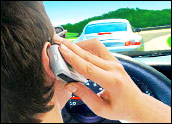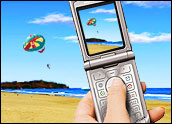
As states and other government jurisdictions continue to enact — and enforce — restrictions on the use of cell phones while driving, consumers are suddenly demanding more, easy ways to access their mobile phones and improve their safety.
A new survey demonstrates that more than 75 percent of cell phone users would like to use speech commands while driving, which would enable them to have hands-free and eyes-free access to their mobile phones.
The survey — sponsored by technology developer Nuance Communications — of nearly 2,000 mobile phone customers in the U.S. and the U.K., shows that 60 percent of U.S. respondents use their cell phones while driving. The top reason cited by those who rarely or never use the cell phone while driving is safety concerns.
Messaging, E-Mail, Browsing
Safety requirements are becoming more important than ever since mobile phones are increasingly used for messaging, e-mail and Web browsing, experts said. U.K. survey respondents expressed an “overwhelming interest” in text messaging: with 90 percent of U.K. respondents using text messaging at least once a week, compared to 48 percent of U.S. respondents.
Top line findings of the study included:
- More than half of all respondents are looking for solutions that allow them to drive more safely by keeping their eyes on the road;
- Forty-seven percent of respondents are demanding technology that will allow them to comply with regulations for hands-free mobile phone;
- Thirty-five percent of respondents are interested in speech solutions that enable them to become more productive while commuting.
Safer Mobile Devices
Additionally, consumers are looking for voice-activated MP3 players — for many of the same reasons.
“These survey results highlight the market demand for enhanced speech technologies that enable consumers to unlock the power of cell phones, PDAs and other mobile devices,” said Craig Peddie, vice president and general manager, Embedded Speech Solutions, Nuance.
Manufacturers like LG, Motorola, Nokia, Samsung, Sanyo and Siemens have developed, or are developing, voice activated technologies for mobile markets. Major carriers like Orange, Sprint, T-Mobile and Vodafone have acknowledged support of such features.
During a recent conference in Barcelona, Spain, Nuance debuted new packaged applications for device manufacturers to enable voice-activated dialing, voice control of mobile device functionality and audio output of SMS messages. The applications that bundle speech technology, user interface design and development tools are the direct result of increased user demand for voice technology that enables hands-free and eyes-free use of mobile devices for improved convenience, safety and accessibility.
Nuance does not have the voice applications niche for the mobile market all to itself.
Garmin International, a unit of Garmin Ltd., recently debuted a new feature for its all-in-one Personal Travel Assistant. The nuvi 310 and nuvi 360 will incorporate Bluetooth Wireless Technology, as well as a GPS navigator, MP3 player, audio book player, language translator and other features.
The nuvi’s Bluetooth wireless technology capabilities and integrated microphone and speaker provide for hands-free mobile phone calls. This calling feature lets users dial phone numbers through a touch screen keypad. Users may also look-up and dial numbers from their personalized phone book or from the phone’s call history log that shows calls received, calls dialed and calls missed, according to Gary Kelley, vice president of marketing for Garmin International.
Meantime, another developer, Jabra, has added six new music products to its existing wireless Bluetooth headset portfolio, for use with the mobile phone, MP3 players and the PC.
“We are focused on establishing Jabra as the world’s leading brand of audio products for mobile devices and the number one choice for consumers,” said Morten Steen Jorgensen, president, GN Mobile, the developer of Jabra technology.
Legislation as Marketing Tool
According to Praveen Chandrashekhar, senior research analyst at Frost & Sullivan, based in London, with legislation being implemented to enforce mandatory hands-free telephony while driving, the technology trend will continue.
“Bluetooth has become the standardized wireless technology in most automotive applications,” said Chandrashekhar. “Using this mandatory legislation as a key marketing tool to spur awareness of wireless technologies — such as Bluetooth — and their implications on driving safety will facilitate increased market penetration.”
What is more, he said, carmakers are also likely to implement upcoming Bluetooth applications such as remote vehicle diagnostics and wireless control of rear seat entertainment systems. Accordingly, the Bluetooth equipped vehicles market is expected to grow at a compound annual growth rate of 27.1 percent in the period 2005 to 2010.




















































